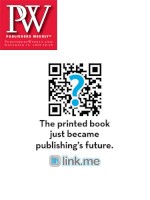This fall two New York City independent children's bookstores are hitting big numbers, at least birthday-wise. Bank Street Bookstore is marking its first four decades, while Books of Wonder just turned 30. What makes their longevity even more remarkable in a city where real estate can be destiny is that they have done so despite the recession and without compromising their focus on children's books.
At Bank Street, which is owned by the Bank Street College of Education, "We have a lot of regular customers who stop in multiple times a week," says longtime manager and buyer Beth Puffer. "So you have to keep doing things new and fresh." That means changing displays as new books come in, mounting displays themed for holidays like Thanksgiving and Ramadan or subjects like apples, and promoting the top 40 books from the past 40 years in honor of its ruby anniversary.
Although the store continues to cater to kids, parents, grad students, and teachers, it no longer stocks textbooks. Six years ago Bank Street made an arrangement with an online textbook company, Akadémos. "Students get a better price and can buy used. They're even going into rental," says Puffer, who has no regrets about no longer having to devote time, money, and space to textbooks.
Bank Street's inventory of 50,000 titles, learning games, toys, and classroom supplies reflects Puffer's concern for having books that show the diversity of children's experiences. In addition to having a large social studies section and sections on various countries, cultures, religions, and family makeups, the store stocks a number of Spanish- and French-language titles. "I'll order any children's book in any language," Puffer says. "I love having books in Farsi, Yiddish, and Albanian."
In addition, Bank Street maintains an active Web site through the ABA's IndieCommerce program. The books are as carefully culled as in the bricks-and-mortar store, although the orders tend to come more from schools than individuals. Booksellers at Bank Street have to pass a quiz on children's books and are expected to read children's books daily on their own time. I can't remember the last time I read a grownup book," Puffer says. "We read kids' books constantly in order to make recommendations for every age, reading level, and interest."
Even with such a vast repository of knowledge and a loyal customer base, Puffer attributes the nonprofit store's longevity in large measure to its ownership. "Being institutionally owned has certainly been a great aid," she says. "They believe that we are not just a financial part of the college but a public relations part."
By contrast, Peter Glassman, who dropped out of Brown in 1980 to start Books of Wonder when he was 20, ascribes his store's staying power to "the amazing love, support, and loyalty of authors and artists in the children's community." He credits well-known writers like Madeleine L'Engle, who told Farrar, Straus, and Giroux that she wouldn't tour unless Books of Wonder was a stop; Lloyd Alexander, who came to the store long after he stopped touring elsewhere; and Maurice Sendak for helping to establish the store early on.
Events, as many as four a week, continue to be an integral part of Books of Wonder. For Glassman, events go a long way toward making the store feel special—a destination where books are found and authors met. He continues to book big-name authors like Suzanne Collins, who launched her Mockingjay tour at Books of Wonder, by not taking "no" for an answer. "It's always been my viewpoint," Glassman says, "that 'no' is not an end to a discussion. If you hit a wall, you go over it, under it, or cut a door in it."
Glassman also credits his late partner, James Carey, for his faith and support, as well as publishing friends like Janet Schulman at Random House, John Sargent at Macmillan, and Michael di Capua, now at Scholastic, who helped him understand the business. He gained further insights as a children's book author himself: The Wizard Next Store, My Working Mom, and My Working Dad. Above all, says Glassman, "one very important thing is that we never stopped being a bookstore. Over 90% of our inventory is books. When you come in our store, you know you're in a bookstore. We never lost sight of the fact that our first and primary mission is to put great books in kids' hands."
That doesn't mean that Books of Wonder hasn't branched out as it has grown from its first 150-sq.-ft. location to a space more than 20 times larger. Rare and collectible books account for roughly 20%–25% of sales. The store also sells art by children's book illustrators, which is another 10%. And although the BOW publishing program, which launched with Morrow in 1984, has been idle for the past few years, the store copublished nearly 60 gift editions of classic children's books. Neither Puffer nor Glassman worry openly about a coming digital revolution in kids' books. "People come to us for so much advice," says Puffer. "We'll stay in the game. We're still the curators."



 Volume 257
Issue 45
11/15/2010
Volume 257
Issue 45
11/15/2010





